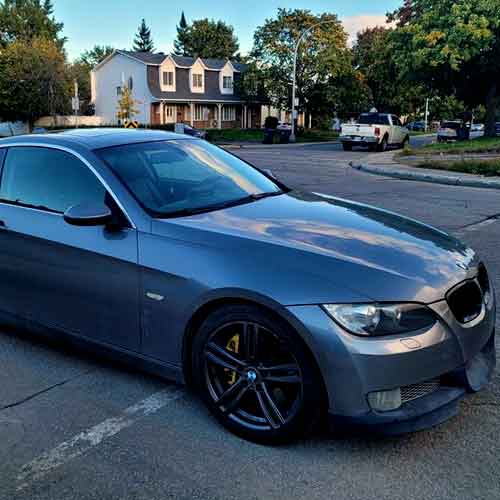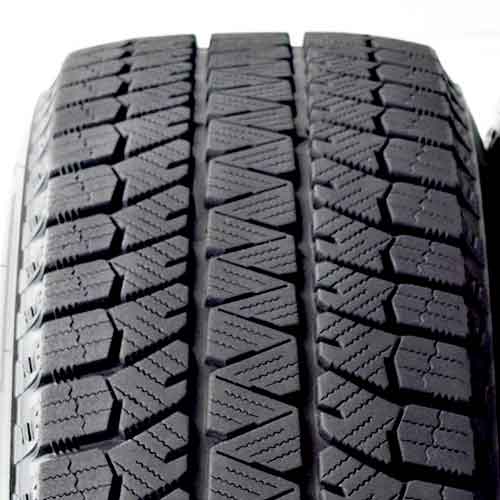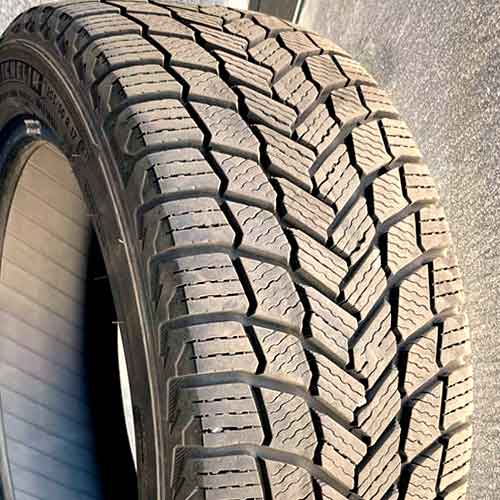A gripping contest is underway as Bridgestone Blizzak WS90, armed with its unique rubber compound for maximum winter grip, challenges the Michelin X-Ice Snow, celebrated for its advanced tread design for better handling. Will the ice reveal a clear victor in this contest of winter champions?

Table of Contents
Info on Sizes
The Blizzak WS90 (review) comes in 52 total sizes in 15 to 19 inches (wheels) with following specs.
- Speed ratings: T or H.
- Load ratings: SL or XL.
- Tread depth: 11 or 12/32″.
- Weight: 17 to 29 lbs.
- Tread warranty: None.
On the other side, the Michelin X-Ice Snow (review) comes in 125 total sizes in 15 to 22 inches. They have following specs.
- Speed ratings: T and H.
- Load ratings: SL and XL.
- Tread depth: 10.5/32″ on all.
- Weight: 16 to 40 lbs.
- Tread warranty: 40k miles.
Tread Design
The Bridgestone Blizzak WS90 showcases a very uniquely designed directional tread pattern.

This pattern consists primarily of three defined ribs, with the central one being continuous. So yes, you can say, that the shoulder lugs cover majority of the tread’s area.
The central most rib come with full depth interlocking sipes and incisions which for triangular shaped block pattern.
These incisions basically vary in width, and this provides you with amazing biting efficacy. And adding to that are it’s V shaped notches facing both sides (laterally).
These notches are joined up with these incisions I talked about.
Moving towards shoulders, you see more biters.
There are notches facing the middle. Then there are longitudinal incisions of varying length (just as seen on the central lugs). These actually split up the shoulder blocks.
Moreover, you also get more zigzag siping at the end there. And of course all these lugs are laced with regular wave like sipes seen everywhere else on the tread.
On the other hand, Michelin X-Ice Snow showcases a distinctive, directional tread pattern too.

It’s tread is equipped with 4 circumferential grooves which are formed by 4 total ribs, which are formed by 6 total ribs.
The central most longitudinal groove is the narrowest and very tough passing. It’s formed by two ribs containing blocks having multiple sharp edges, wave-like sipes, and chamfered sides facing the shoulders.
The outer surrounding lugs although also carry similar tread features, they have slightly wider spaces around them, and lugs are overall smaller.
All these blocks (including the shoulders), are interconnected with each other. You can say, they are all lying on a secondary rubber layer underneath, which accounts for lug stability as the tire maneuvers.
The shoulders carry slightly softer edges, and so they are a bit squared off, you can say.
Moreover, these lugs carry rectilinear lateral siping on them. And their outer edges also have notches on them.
Wet Traction
Wet traction is primarily governed by a duo of elements: the tread pattern and the rubber compound. These dictate the tire’s grip and its defense against hydroplaning. Let’s unpack them.
Wet Grip
While both tires come armed with ample siping and adaptable tread rubber, the Bridgestone Blizzak WS90 manages to seize an advantage in the grip department.
And the reason is the tire’s dual siping design, which showcases an array of rectilinear and interlocking patterns of these slits.
Basically sipes work by drawing in water particles, enabling the biters to latch onto the slightly dried surface, and with dual siping design, as seen on Blizzak, those slits become like water magnets.
The Michelin X-Ice Snow on the other hand, although shows up with a ton of biters as well, combined with multi-directional sipes, the missing rectilinear slits in longitudinal directions don’t allow the tire to have as great of a lateral traction (on corners), as the WS90.
So Michelin has the upper hand here.
Hydroplaning Resistance
Hydroplaning arises when water obstructs the tread from making proper contact with the underlying surface, causing the tire to float a bit and losing all traction, which as one might imagine, is a major issue.
And here, between the two, the Michelin X-Ice Snow takes the lead, with its wider grooves, and sweeping arms, which allow the tire to have better average float speeds, excelling in both curved and straight aquaplaning tests.
The tire basically comes out with a genius design here, not only it offers a directional tread pattern, which swoops water off the surface of the tread, those lugs are divided up, so you get an interconnected web of grooves, running every which way, allowing for effective dispersing of water in all directions.
The Blizzak WS90 on the other hand, lacks here with its symmetric tread pattern, and missing inter-connectivity of tread voids.
Dry Traction
Dry traction is a two-part story, involving directional grip and handling. Let’s discuss them both.
Directional Grip
Dry grip hinges on the central portion of the tread since it’s the primary contact point with the road, particularly for winter tires, given their rounded contact patch and predominantly directional design.
Though this design isn’t always the best, and that explains why the Bridgestone Blizzak WS90 takes the lead in this area, showing up with faster braking efficacy.
The tire’s symmetric tread pattern showcases a continuous running central rib, maintaining an uninterrupted bond between the rubber and the road. This ensures superior braking distances, a key measure of directional grip.
Conversely, the Michelin X-Ice Snow doesn’t fare as well with its wider tread voids, and so its unable to offer a similar contact patch. Though its directional grip is still much better when you consider its handling capabilities.
Handling
The overall ability of a tire to maintain traction, especially during cornering, largely depends on its shoulder lugs. There are two key factors we evaluate in this context. Firstly, we examine how effectively the lugs interact with the surface as the tire swivels. Secondly, we measure the extent of lug flex that occurs during such maneuvers.
When looking at the Michelin X Ice Snow, we see that it displays a similar level of contact between the rubber of its shoulder lugs and the road, when compared to its competitors. However, despite this similarity, its increased weight still hinders its overall performance in this domain.
Essentially, as the tire makes turns, the weight it carries shifts towards its edges, also known as the shoulders. And so in the case of a heavier tire, the lugs on the shoulders are subjected to increased bending, which in turn disturbs the delicate balance between oversteer and understeer, ultimately causing a delay in steering feedback.
Therefore, due to its weightier structure and wider grooves, the Michelin X-Ice Snow displays extended handling lap times, compared to its counterpart.
Fuel Efficiency Assessment
Fuel efficiency in tires is closely linked to their road grip and overall weight.
In this context, the Michelin X Ice Snow leaves room for improvement. Specifically, the tire’s considerable weight and extensive tread voids heighten its rolling resistance and friction with the road surface.
On the other hand, the lighter Blizzak WS90 imposes less pressure on the road, leading to reduced overall friction. Furthermore, its longitudinally aligned tread ribs align with the tire’s direction of movement, minimizing resistance, conserving energy, and thereby enhancing fuel efficiency.
So Ws90 has the upper hand, when it comes to overall fuel economy performance.
Ice Traction
When navigating icy surfaces, the Bridgestone Blizzak WS90 unequivocally showcases its superior performance, outclassing its counterpart.
On tests the tire achieves a significantly quicker stop time by an average of one second, which incidentally, is a trend mirrored in its acceleration capabilities (up to 40 mph).
But why does the Michelin tire under-performs here? Well there are a couple of things to consider here.
First, the tire although has a lot of siping just like its peer, its still not as aggressive as seen on the WS90. Moreover, the tire is also missing with any kind of notches and has wider tread voids (which makes blocks).
In comparison, the Bridgestone Blizzak WS90 excels due to its superior biters. Its central rib comprises an assortment of angled cuts, V-shaped notches extending in both lateral directions, and an abundance of siping, all of which contribute to an exceptional ice-biting performance.
The biters’ dual-angle design further elevates the tire’s grip, thereby enabling efficient braking. When it comes to handling, the tire’s shoulder lugs are crucial, and they come equipped with biters oriented both laterally and longitudinally, ensuring a comprehensive grip from every conceivable angle.
Therefore, when it comes to ice traction, the Bridgestone Blizzak WS90 clearly outperforms its competition.
Snow Traction Analysis
When navigating snow, you can’t beat the Michelin X Ice Snow as this tire demonstrates a far much more commendable traction capabilities, compared to ws90.
To clear up things, I am talking about fluffy snowy terrains here.
The X Ice Snow’s wider tread voids basically facilitate superior snow-to-snow contact here, which is exactly what you need here. Its lug voids adeptly trap powdery snow particles within their interconnected grooves and snow vices, and connected with the ground (with that lodged up snow).
Its better because snow sticks better on snow, instead of rubber.
The Blizzak WS90 on the other hand, is designed with a more enclosed structure that isn’t able to do so as effectively.
So, when considering overall snow performance, the Michelin X Ice Snow is the superior choice.
Comfort Level Assessment
The comfort level provided by a tire is largely determined by the amount of road noise it generates and its ability to dampen vibrations. These characteristics are mainly influenced by the tire’s construction.
Let’s delve into each aspect.
Tread Noise
Noise is generated when air particles collide with the walls of the tire tread. Consequently, larger tread voids tend to produce louder noise.
Comparing the two tires, the Bridgestone WS90 stands out for its quieter ride. This is primarily due to the more compact shoulder lug design, which is where most of the air enters. Additionally, the tire’s central lugs are densely arranged, leaving less space for air particles to move around, thus creating less noise.
Furthermore, any residual noise is effectively diminished by the tire’s advanced pitch sequencing technology.
As these features are lacking in its counterpart, the Bridgestone WS90 offers a quieter ride overall.
On-Road Vibration
While the Michelin X Ice Snow might be a bit noisier, it performs exceedingly well in terms of impact comfort.
This can be attributed to two factors. First, its tread rubber is more absorbent to bumps. Second, it features a deeper tread, which provides a thicker layer of rubber between the vehicle and the bumps, enhancing its shock-absorbing capabilities.
Therefore, in terms of bump absorption, the Michelin X Ice Snow outperforms its competitor.
Tread Longevity Evaluation
Tread longevity is largely influenced by rolling resistance, particularly when considering these two tires.
In this regard, the Blizzak WS90 emerges superior. Its reduced weight places less strain on the tread blocks during contact with the road, leading to less friction and slower wear of the rubber.
In contrast, the heavier Michelin X Ice Snow channels its extra weight onto a smaller rubber surface due to its larger tread voids. This added stress on each lug hastens tread wear, thereby diminishing its overall lifespan.
However, it’s worth noting that the performance difference between the two tires is relatively minor, which explains the absence of specific warranties.
So in essence, you get a longer life on Blizzak WS90.
So what’s the verdict?
Although its not recommended that you skip any of the above, let me summarize the things below.
In terms of wet traction, the Bridgestone Blizzak WS90 outperforms its counterpart with superior grip, thanks to its dual siping design. However, for hydroplaning resistance, Michelin’s wider grooves and interconnected voids offer better performance.
For dry traction, the Blizzak excels in directional grip due to its continuous running central rib, while Michelin’s weight and wider grooves limit its handling performance.
In terms of fuel efficiency, treadwear, and ice traction, the Bridgestone WS90 takes the lead due to its lighter weight and superior biters.
And lastly, for snowy traction, you get to see a superior performance on Michelin.